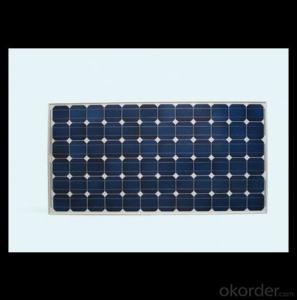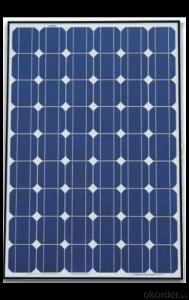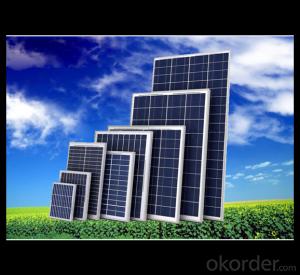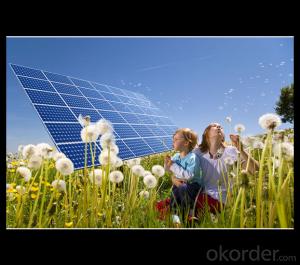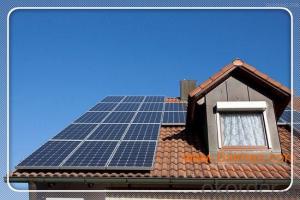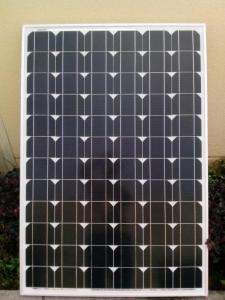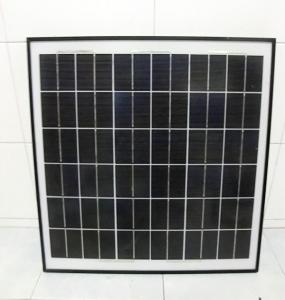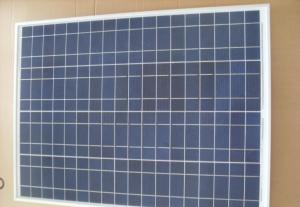Mkbhd 200w Direct Factory Sale Price Per Watt Solar Panels
- Loading Port:
- China main port
- Payment Terms:
- TT OR LC
- Min Order Qty:
- 10000 watt
- Supply Capability:
- 100000 watt/month
OKorder Service Pledge
OKorder Financial Service
You Might Also Like
Specification

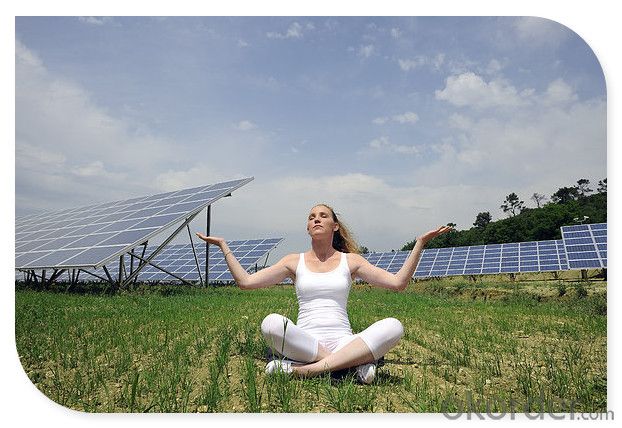
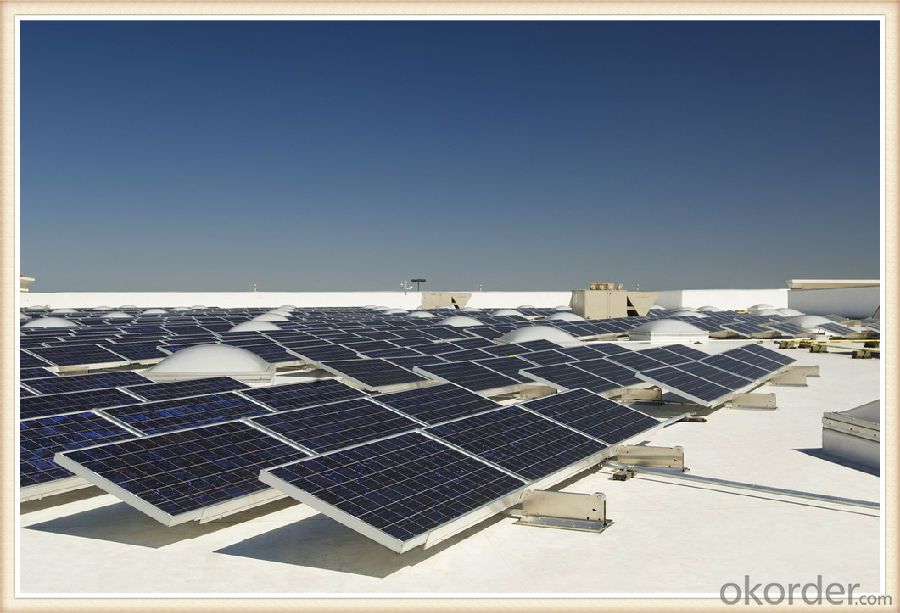
Solar Module Introduction
Solar modules use light energy (photons) from the sun to generate electricity through the photovoltaic effect. The majority of modules use wafer-based crystalline silicon cells or thin-film cells based on cadmium telluride or silicon. The structural (load carrying) member of a module can either be the top layer or the back layer. Cells must also be protected from mechanical damage and moisture. Most solar modules are rigid, but semi-flexible ones are available, based on thin-film cells. These early solar modules were first used in space in 1958.
Electrical connections are made in series to achieve a desired output voltage and/or in parallel to provide a desired current capability. The conducting wires that take the current off the modules may contain silver, copper or other non-magnetic conductive transition metals. The cells must be connected electrically to one another and to the rest of the system. Externally, popular terrestrial usage photovoltaic modules use MC3 (older) or MC4 connectors to facilitate easy weatherproof connections to the rest of the system.
Specification
Model Type | |
Peak Power-Pmax(W) | 5-200W |
Open Circuit Voltage-Voc(V) | 44.2 |
Maximum Power Voltage-Vmp(V) | 36 |
Short Circuit Current-Isc(A) | 5.4 |
Maximum Power Current-Imp(A) | 5 |
Maximum System Voltage | 1000V DC |
Maximum Series Fuse Rating | 10A |
Power Tolerance | -1~+3% |
Temperature Coefficients of Pmax | -0.45%/℃ |
Temperature Coefficients of Voc | -0.348%/℃ |
Temperature Coefficients of Isc | 0.031%/℃ |
Nominal Operating Cell Temperature | 44.5±2℃ |
Standard Testing Condition(STC) | Irradiance:1000W/m²;Temperature:25℃;AM=1.5 |
Qualification Test Parameters | |
Operating Temperature | -40℃~+85℃ |
Storage Temperature | -40℃~+85℃ |
Pressure Bearing | ≥5400Pascal/m² |
Wind Bearing | ≥5400Pascal/m² |
Mechanical Characteristics | |
Cell Size | Mono 125*125mm±0.5 |
No.of Cells | 72pcs(6*12) |
Dimension | 1580*808*40mm |
Weight | 15.5Kg |
Glass | 3.2mm High Transmission,Low Iron |
Frame | Anodized Aluminum Alloy |
Junction Box | IP65Rated |
Internal Diodes | 3 Bypass Diodes |
Cable | 1*4.0mm² Length 900mm |
Images
Packing & Shipping:
We have rich experience on how to pack the panels to make sure the safety on shipment when it arrives at the destination.
The normal size is packed by 25pcs/ carton / pallet. Paper carton for FCL shipping and wood carton for LCL shipping.
Features
1.High reliability with guaranteed -3% to +5% power output tolerance, ensuring return on investment
2.High conversion efficiency based on leading innovative photovoltaic technologies
3.Withstands high wind-pressure and snow load, and extreme temperature variations
4.Attractive appearanceUnique frame design, high mechanical strength, and easy Installation
Warranty:
For c-Si panel: 25years output warranty for no less than 80% of performance, 10 years output warranty for no less than 90% of performance. Free from material and workmanship defects within 5 years.
For a-Si panel: 20 years output warranty for no less than 80% of performance, 10 years output warranty for no less than 90% of performance. Free from material and workmanship defects within 2 years.
•100% product quality protection
•100% on-time shipment protection
•100% payment protection for your covered amount
FAQ:
(1)What price for each watt?
It depends on the quantity, delivery date and payment terms.
(2)What is your size for each module? Can you tell me the Parameter of your module?
We have different series of panels in different output, both c-Si and a-Si. Please take the specification sheet for your reference.
(3)Can you provide the peripheral products of the solar panels, such as the battery, controller, and inverter? If so, can you tell me how do they match each other?
Actually we are only manufacturer of solar panels, but we could try to source them for you in China if you need. We could provide you an optimal system design to instruct you how to install.
(4)Do you have the CE, TUV, UL Certification?
We’ve already passed all the tests, and any certificate is available.
(5)Have you ever sold your products to companies in my country?
Of course, we have customers in all general PV markets, but I think we should expand our market share along with the market growth.
(6)When did your company set up? You are a new company, how can I believe your quality?
We entered into Solar PV industry in 2005, now we have several plants in manufacturing of a-Si and c-Si panels, and our capacity is 220MW per year. Till now we have already passed all the tests by authorized laboratories, e.g. TUV, VDE, UL.
(7)Can you help us install the module if we cooperate with you?
We haven’t entered into installation sector, but we have the plan in near future.
(8) How do you pack your products?
We have rich experience on how to pack the panels to make sure the safety on shipment when it arrives at the destination.
(9) Can you do OEM for us?
Yes, we can.
(10)Can we visit your factory?
Surely, I will arrange the trip basing on your business schedule.
- Q: Is there a free site or resource that will teach you how to do this? Hopefully step by step and tells you how to buy all the parts ect?Which is the best resource for sale earth4energy, homemadeenergy, ect? Do they actually work and also as well as those which are professionally done?They say it will cost under $200 for a panel, but how much will this panel actually produce I mean how many panels would you have to make to produce 00% of your homes energy?
- I have no idea the out put of the panel you plan to make, but $200.00 will not even come close to power much. You don't say whether you want to power your house straight from the solar panels (not possible, because the sun doesn't shine 24/7). That being said,you will need a very large array to power your house,going to battery's to inverter to get AC power. Your initial cost would be around $25000,00, but you might be eligible for a tax rebate and maybe a rebate from your state and power company. There is a lot more to be said on the subject,but this is enough to either get you started or discouraged.
- Q: How can I start working as a solar panel installer/technician without years of education?
- The best suggestion I can give is to call solar installation companies in your area, and ask for their recommendation as to what to do. They may recommend a technical college with an appropriate program. With unemployment rising, new jobs in solar will likely be scarce for a while. You might also inquire at roofing companies. If you apply at a solar company, and can demonstrate that you already have roofing experience, that will be a plus.
- Q: Can solar panels be installed on historic homes or buildings?
- Yes, solar panels can be installed on historic homes or buildings. However, it is important to consider the specific regulations and guidelines set by local historic preservation boards or authorities. In many cases, there are alternative installation methods available that minimize any visual impact on the historic aesthetics of the building. It is advisable to consult with experts in historic preservation and solar installation to ensure compliance with any necessary requirements.
- Q: Can solar panels be installed on a car or electric vehicle?
- Yes, solar panels can be installed on a car or electric vehicle. These panels can be mounted on the roof or other suitable areas of the vehicle to capture sunlight and convert it into electricity, which can then be used to power various components or charge the vehicle's battery. However, the amount of energy generated by these panels may be limited, and they are typically used as a supplementary source rather than a sole power provider for the vehicle.
- Q: can solar power panels installed at home provide enough electricity to power house hold appliainces and heat water.
- During daylight hours yes. I have just six panels, and during the summer, with feed in tariffs paid by my retailer, I hardly pay any electricity bills. Many people around me have up to 20 panels on their roof, and are gross feed in to the grid, meaning no more electricity bills. * or preferably 0 panels will ensure you never have to pay an electricity bill again.
- Q: Can solar panels be installed on desalination plants?
- Yes, solar panels can be installed on desalination plants.
- Q: does it mean that it can get that much in a day? Or like, in an hour?
- Wattage okorder
- Q: We have LED at the output of 40 watts and is used for 0 hours giving us 400 Watts-hr of energy consumed.Rechargable batteries needed are 2 V. 400/2 gives us 34 Ampere-hour battery needed. If we want it for 3 days, It would be 34x3=00 Ah. So the battery needed 00 AhNow how do I select the solar panel which can charge this/these batteries? What should be its rating?
- First, you need to make sure that your battery can take a regular 34Ah discharge without damage. The usual wisdom when using deep cycle lead-acid batteries is to allow for no greater than 50% discharge. This is to prevent the battery from ageing prematurely. Note that automotive batteries are not usually considered suitable for deep-cycle applications. Best allow for at least 200Ah capacity. Your solar panel capacity needs to take into account that whatever the nameplate output of the panel, that will be what it will produce under ideal conditions, actual output will always be less, often quite a bit less. You also need to allow capacity to cope with dull, overcast days when the light level is very low. You can get solar maps that will give you the sunshine hours and irradiation levels at your location. The solar panel capacity ends up being a juggling act between available funds/space and how critical it is that the light always works as desired. Let's say you had a 400W panel, which sounds quite generous. In the middle of winter, it may produce only 75W for 5 hours on a dull day, not quite enough to run the light for 0 hours. Would you expect several such days in a row? How many days could a 00Ah of battery capacity cover under these conditions?
- Q: hi, i got a pond and i am planning of putting some lights on it during night time. but i want to use solar panels and i have done a bit of research about solar panels and i know how they work, i know that the common voltage to use is 2v so you can use car batteries or deep cycle batteries, but my question is:. what wattage of bulb can you recommend2. how long it would take to drain my battery (can i have it overnight)3. and what wattage of solar panel should i get enough to recharge my battery the next day.hope anyone can help..thanks
- select 2V, and it will tell you how big of a battery bank and how big of a solar panel you need. For my example, I need a 7ah 2V battery and a 20watt panel.
- Q: Is it as simple as buying the panels, an inverter and plugging it into a wall-socket, assuming it would just send power back into the outlet and supplement my house's electrical usage, or... Is it not that simple?Remember, I'm talking about a SMALL system, and I don't care how little power it'd make, or how uneconomical it would be.
- How to tie small solar panel system into my house's electircal system? It's very complicated. Just for starters, if you plugged your solar panel into your electrical outlet, you would probably see smoke and fire, not electricity. Of course anything CAN be done. But this one is truly unfeasible at the consumer level. The only way to send power back into a live system is to synchronize the phase voltages. In your case you would require the solar panels, a battery backup system, a voltage inverter and some type of industrial synchronizer (probably a generator) so you could sync your inverter output to the utilities output. Solar is still more of a standby or supplemental type power at this time. The easiest way is to supplement your hot water by using solar panels to heat water rather than create electricity. If money was not much of an option then you could theoretically run your whole house without the need for any synchronization but have a gasoline or diesel generator to keep your battery pack topped up when needed.
Send your message to us
Mkbhd 200w Direct Factory Sale Price Per Watt Solar Panels
- Loading Port:
- China main port
- Payment Terms:
- TT OR LC
- Min Order Qty:
- 10000 watt
- Supply Capability:
- 100000 watt/month
OKorder Service Pledge
OKorder Financial Service
Similar products
Hot products
Hot Searches
Related keywords
